Friday, February 5. 2010
Jennifer Liston Poetry Website Launched
 Make yourself a coffee and head over to Jennifer's new website, http://jenniferliston.com, which is her own little cobwebby corner of the poetry world!
Make yourself a coffee and head over to Jennifer's new website, http://jenniferliston.com, which is her own little cobwebby corner of the poetry world!Be prepared to be entertained, amused and perhaps at times a little challenged with her beautiful and thought provoking words.
... Robert
Monday, January 25. 2010
Edithburgh Sun Shots - Leafy In The Sunlight
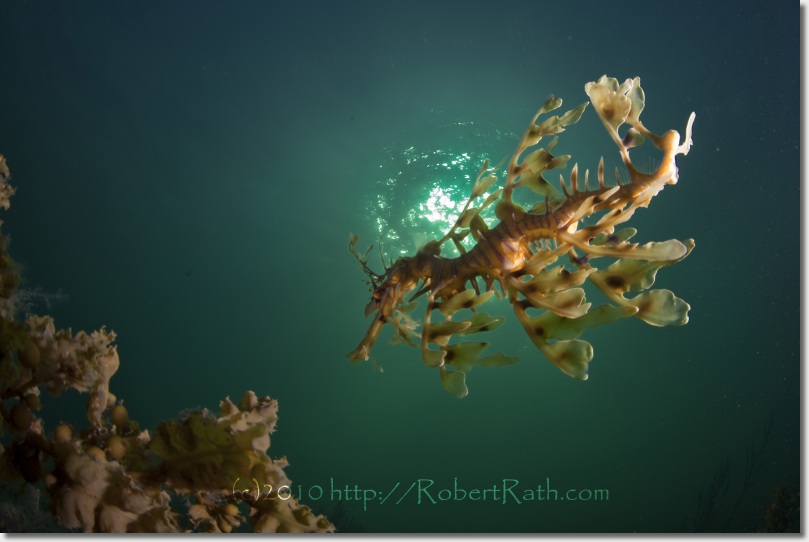
Yesterday I took a set of images from Edithburgh specifically experimenting with shooting into the sun. Please excuse the backscatter, no cleaning up has been done.
More photo's from the 'Edithburgh Sun Shots' dive can be found here at Edithburgh Sun Shots (Facebook Album) or my slideshow on Flickr.
Until the next post, take care out there and keep diving ( if that's what you do! ) ...Robert
Photo: Robert Rath, Leafy Seadragon, Edithburgh. Please ask if you want to know more about how this image was taken.
Friday, January 8. 2010
Portrait of a Sausage Jelly

My first recollection of Sausage Jellies is seeing masses of them washed up on our local beaches resulting in them being squished through each other's hair, thrown at each other as in snowball fighting and generally not appreciating what they really were. We thought at first they were some strange jellyfish that seemed to have no sting. Soon someone started a rumour that they were really eggs, but eggs of what?
Well the rumours turned out to be true and indeed the Sausage Jelly is a blubbery mass of thousands of eggs of either the Conical Sand Snail Polinices conicus or the Sordid Sand Snail Polinices sordidus. These little snails are responsible for the very familiar sight of cockle shells washed up on beaches with neat little holes drilled in the side. The Sand Shell is predator and hunts these bivalves, attaching themselves to some poor cockle, drilling a neat little access hole with a rasp-like tongue and devouring the poor little critter now defenceless from attack.
This photo of a Sand Snail egg mass was taken last week while diving at Pt Noarlunga. This Sausage Jelly floating in the water presented the perfect opportunity to capture its beautiful form and show off the individual eggs distributed through its mass in way not seen in one simply washed up on a beach.
More photo's from last week's dive can be found here at Sigma 15mm FE First Tryout (Facebook Album) or my slideshow on Flickr.
Until the next post, take care out there and keep diving ( if that's what you do! ) ...Robert
Photo: Robert Rath, Sand Snail Egg Mass, Pt Noarlunga. Please ask if you want to know more about how this image was taken.
Friday, November 20. 2009
Juvenile Southern Squid Are Very Cute
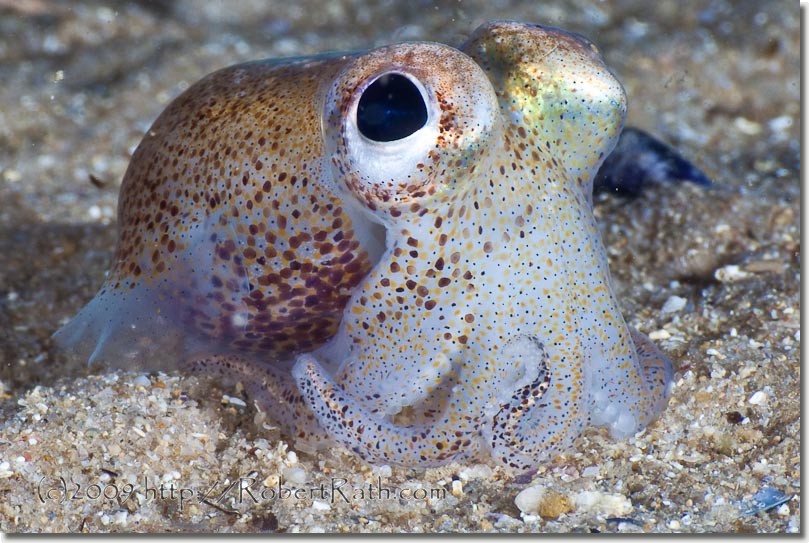
Night diving is always great fun and often full of wonderful little surprises (big surprises are OK too so long as they are under 3m). Last night Matt and myself descended below the ever popular Pt Noarlunga Jetty just shy of midnight. The usual suspects showed up on cue and I got the chance to play a little bit more with my new rig.
About midway into the dive a little squid no bigger than a golfball turned up out on the sand. At first I thought he was one of the local Southern Dumpling Squid. The colours seemed right even if a bit pale, though you can never really tell with cephalopods. Those cute little bug eyes did not seem right though, they seemed too big for a dumpling squid. Shortly after taking this image he rose and swam directly at my camera lens. A behaviour I have never experienced with dumpling squid.
Today I had a closer look at the photograph, the eyes, the colours on the wings and the presentation of the chromatophores and decided he must be a juvenile Southern Calamari (Squid), Sepioteuthis australis.
All up we had a great dive and it was a real pity I could not convince a few other friends to join us. It seems than diving invitations are not so popular after 10pm on a normal working weeknight! Oh well, there's always next time.
More photo's from last night's dive can be found here at Midnight Pt Noarlunga (Facebook Album) or my slideshow on Flickr.
Until the next post, take care out there and keep diving ( if that's what you do! ) ...Robert
Photo: Robert Rath, juvenile Southern Calamari, Pt Noarlinga Jetty (Night). Please ask if you want to know more about how this image was taken.
Monday, November 16. 2009
The Monster In Our Kitchen
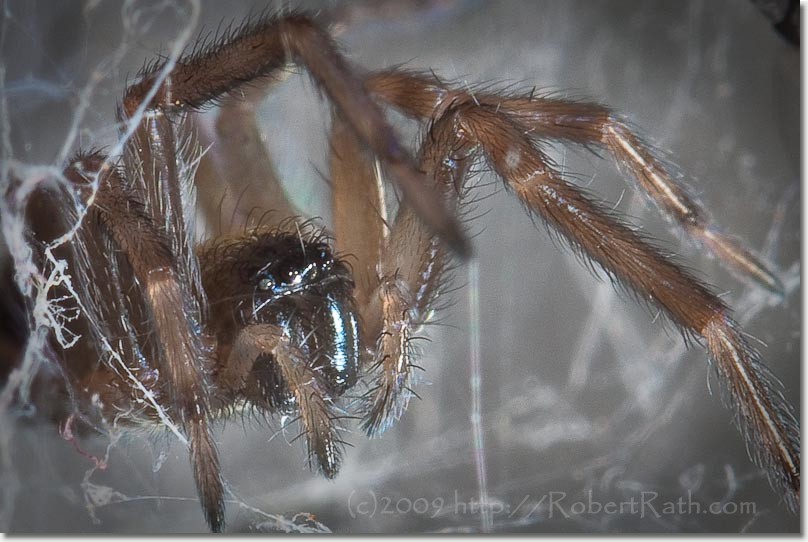
Today I noticed a tiny tiny spider in a messy little web high up on the window frame and wondered what it would be like to be a fly! The amazing thing about really little things is how amazing they look from their own perspective instead of ours.
I hardly even noticed this little gal up there and when I did it was really a case of 'so what'. But, once I shrunk down to her size it was a different story altogether! Thoughts of Frodo Baggins being be captured and dragged off by the great Shelob came to mind and in an instant I decided she had to go. Just as soon as I took a photo and returned to human size again of course! You just can't let monsters live in your kitchen. You never know what mischief they will cause.
Nothing in the image gives any indication of her true size. In fact the frame is less than 5mm across!
Until the next post, take care out there and stay away from monsters! ...Robert
Photo: Robert Rath: Shelalob (Shelob's Australian cousin) ready to pounce!
Saturday, November 7. 2009
Port Noarlunga Reef The Beautiful and Diverse Gap
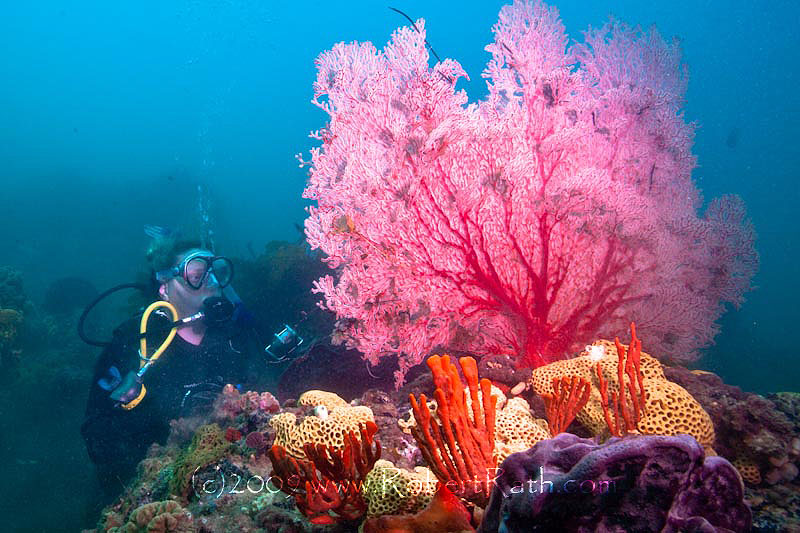
Port Noarlunga is a bustling beach-side suburb about 40 minutes south of Adelaide. Easy to get to, easy to access the water via the jetty and with the Adventure Blue dive store close at hand makes Pt Noarlunga the most popular shore dive destination near Adelaide.
The main attraction here is an extensive reef system running parallel to the shore and accessible from the end of the jetty. The reef is broken into northern and southern sections with a deep gap separating the two. Depths range from 5m to 15m depending on which parts of the reef you dive.
Too many divers never really get to appreciate the fantastic beauty and diversity of this place because they limit their diving to the end of the jetty and the protected side of the northern reef system. This is especially true for new divers who complete some or all of their open water training here and only see a tiny part of the system. They risk overlooking the rest Pt Noarlunga has to offer because of their associations with their initial experiences.
A good way to really see the Pt Noarlunga Reef in a whole new way is to dive 'The Gap'. Access to the gap is by a 300m snorkel south from the end of the jetty. Yes I know that sounds like a long way but it's a much more pleasant 300m than walking the length of the jetty which everyone is prepared to endure! Just stay on the inside close to the reef and take your time to enjoy the critters in the shallows. You can dive this traverse if you like but your time in the Gap will be limited due to initial air consumption. The Gap is obvious where there is no more reef at or near the surface even on a low tide.
Once you descend into the Gap it is like nothing else you will have experienced on the inside of the reef. The seascape becomes one of big bommies and thick kelps. You'll notice a big jump in the diversity and size of fish species. Stunning huge schools of Silver Drummer. Solitary Longnose Boarfish, Sweep and Old Wifes, many species of Leatherjacket, Blue Groper, Magpie Pearch, Western Talmas, Hulafish, Dusky Moorwong, Zebrafish and more. In other words, a fantastic cross section of South Australian reef fish. Colours abound with beautiful Sponges, Ascidians and Corals. Huge Gorgonian Fans catch nutrients in the current and many varieties of Algae complete the scene.
Watch your depth and air here as it is quite easy to get down to 15m and your increased air consumption may catch you by surprise cutting short your dive and enforcing a long snorkel back on the surface. With a third of your air used, start your journey back north along the outside of the reef. You can proceed the full 300m north on the outside if you are happy to clamber over the reef on surfacing to get back to the jetty or if the tide is high. Otherwise I'd recommend only going 100m north on the outside and then surfacing. Locate and traverse the narrow channel though the reef here back to the sheltered inside. Descend again, heading north for the remaining 200m return trip.
Good navigation skills are essential to get the best from this dive so make sure you have a compass and are comfortable with natural navigation techniques. Don't worry too much about getting lost though as the worst result likely is to be red faced and endure a long snorkel back.
So if you are a regular Pt Noarlunga diver and have not yet experienced diving 'The Gap', then please make it your very next thing on your diving 'ToDo' list. If you have never dived Pt Noarlunga before then make the effort to spend the time to do two or three different dives here and make sure 'The Gap' is one of them.
Until the next post, take care out there and keep diving ( if that's what you do! ) ...Robert
Photo: Robert Rath: Belinda Rowland admires a stunning Gorgonian during last week's dive.
Tuesday, November 3. 2009
Portrait Of A Diver
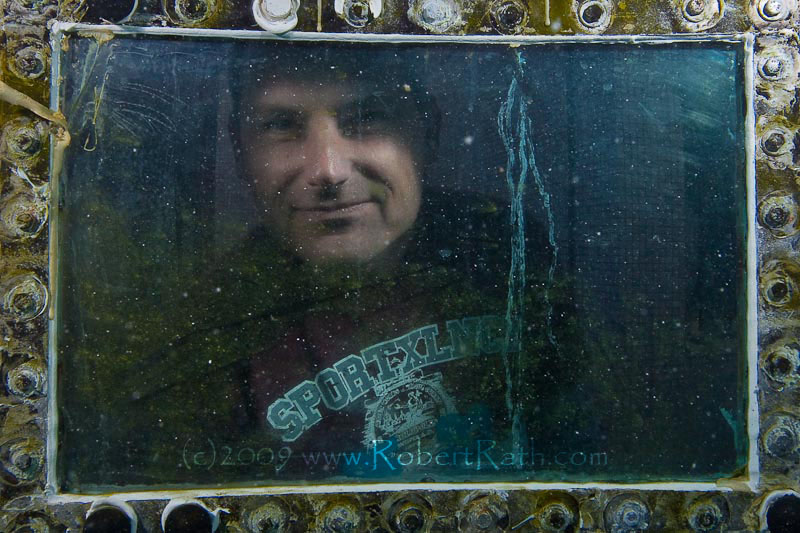
'Portrait Of A Diver' is one of those images that I just can't work out how to categorise. It was one of those surreal images that you never actually see for real. But the image and everything in is real, exactly as the photo was was taken.
Please comment on what you think you might be looking at in my 'Portrait Of A Diver' and what state my friend Gerry might actually be in?
Until the next post, take care out there and keep diving ( if that's what you do! ) ...Robert
Photo: Robert Rath 5DMkII on 'L' plates. (Please ask if you want to know more about how this image was taken.)
Tuesday, October 20. 2009
Midnight Mating Lightning Volutes Under Edithburgh Jetty
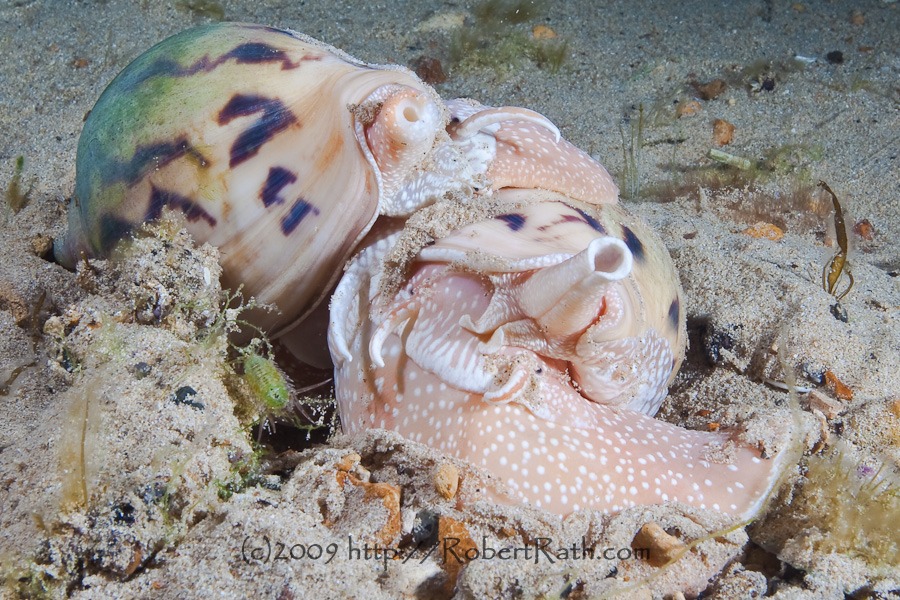
This mating pair of Lightning Volutes, Ericusa fulgetrum was a stunning find on our recent midnight dive under Edithburgh Jetty. We had seen a single volute earlier in the dive in the same location so probably the same guy ( or girl, does anyone know how to tell? ).
This brings me to the wonderful subject of night diving and picking your time. Most night dives take place around late dusk. This is more a factor of logistics and convenience with the added advantage of being able to prepare in some remaining daylight. But just as you will see different things at different times during the day the same applies to the night. As a youngster I remember being on holidays when some of the grownups would head out fishing after we had all gone to bed. The reason, picking the time based on the tides.
In and around Adelaide we often have low tides around midnight so if you can delay your start a few hours and don't mind a late night then try a few midnight dives. You will almost certainly see a level of activity different to a dive soon after sunset. Another good time to see different things is in early morning hours before sunrise. The combination of running tide and remaining darkness will again provide opportunities to see creatures and behaviours different again. And finally try a dive just before dawn and watch first light creeping into the underwater world.
Next time you are planning on doing a dive after sunset try and get creative with the timing. Getting in the water at midnight or getting up at 2am is not for everyone but then neither is experiencing the full scope any one location has to offer.
Until the next post, take care out there and keep diving ( if that's what you do! ) ...Robert
Photo: Robert Rath 5DMkII on 'L' plates. (Please ask if you want to know more about how this image was taken.)
Southern Pygmy Leatherjacket
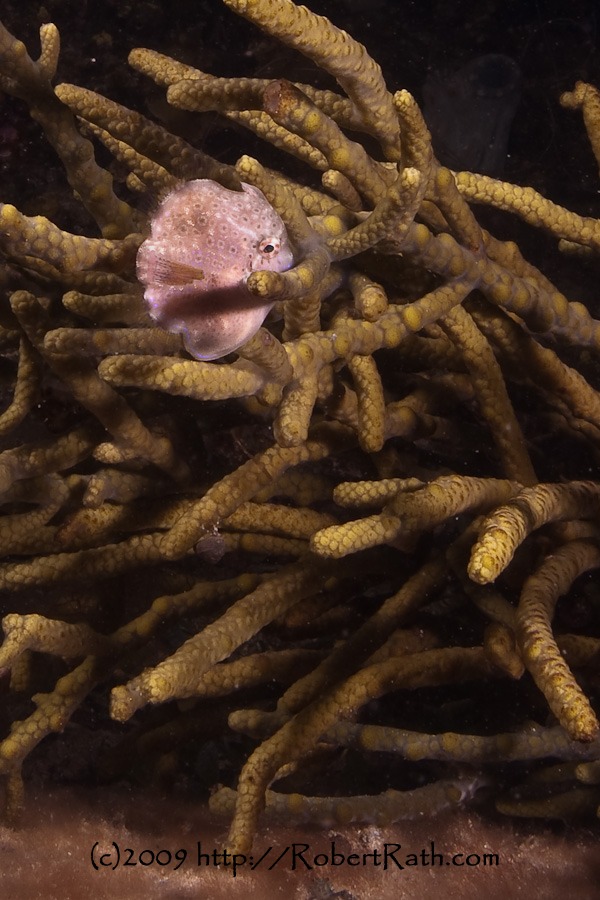
The Southern Pygmy Leatherjacket, Brachaluteres jacksonianus is a common sight under Edithburgh Jetty and always a very cute encounter. This little guy is trying to get some sleep considering it's well after midnight!
He was just one of many wonderful encounters on Friday evening's night dive with our good friends Iain and Susie. Actually Jennifer and Susie ran from the room when I suggested we go for a dive just about the time normal people go to bed. I think Iain only agreed because he thought I was actually joking. The dive that followed was one of our best night dives ever!
Notice something new? Yes, bigger and better photographs! I just love seeing big images and am distressed to find nothing bigger than tantalising thumbnails when I see an image I really like. So from now on I will be trying out a new image size of 900x600. Please let me know what you think and if I should keep with this size or go even bigger! Of course if you really want BIG images we can negotiate an off-site deal!
There will be more Edithburgh images from last weekend along soon. Stay tuned.
Until the next post, take care out there and keep diving ( if that's what you do! ) ...Robert
Photo: Robert Rath 5DMkII on 'L' plates. (Please ask if you want to know more about how this image was taken.)
Monday, October 19. 2009
Arkaroola Wildflowers
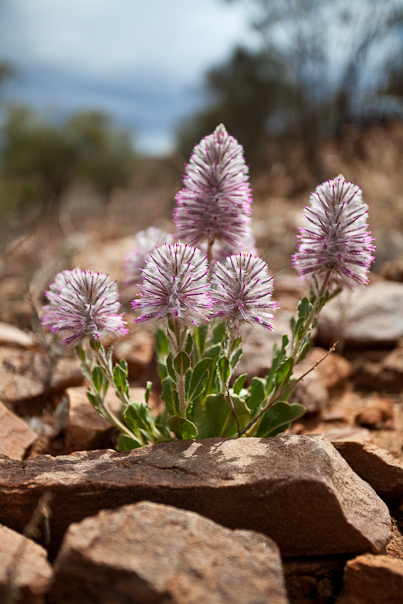
Delicate yet tough. Wild flowers grow in impossible conditions, near the abandoned Bollabollana Copper Smelter, Arkaroola-Mt Painter Wilderness Sanctuary, northern Flinders Ranges, South Australia.
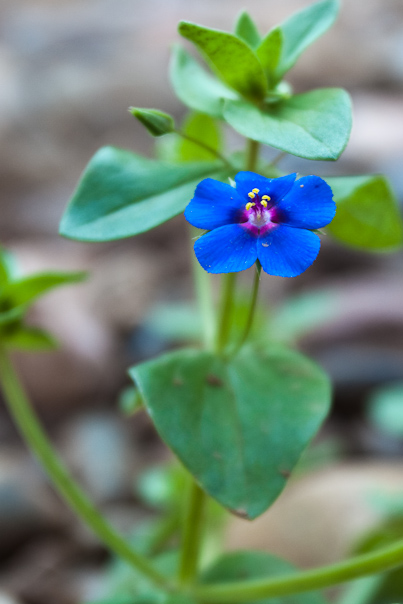
Friday, October 9. 2009
Photos of The 2009 Sumatra Earthquakes
The photos at this link are extraordinary, distressing and deeply moving giving an emmotional glimpse into the Sumatra tradgedy .
http://www.boston.com/bigpicture/2009/10/2009_sumatra_earthquakes.html
http://www.boston.com/bigpicture/2009/10/2009_sumatra_earthquakes.html
Tuesday, October 6. 2009
Taming The Beast - My First Underwater DSLR Photography Experience
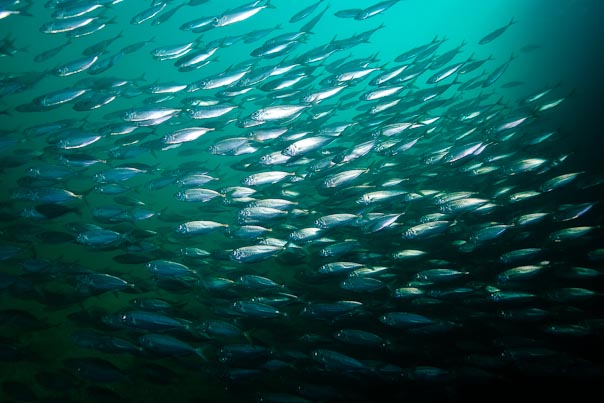
Yesterday's dive at Port Hughes heralded the beginning of a new world for me with my first foray into underwater DSLR photography. Over the past four years I have been using Olympus compact cameras for all of my underwater photography. For the last two years I have been planning my transition to taking a DSLR camera underwater. Finally all of my research, planning, purchasing, customising and doing came to fruition as I stood looking out over Port Hughes Jetty with new rig in hand.
I was very nervous taking 'so much' camera down with me. I double-checked all the seals. I fitted the camera and snapped shut the housing. I fired a few shots to test the strobes. Something was not right but I could not put my finger on it. Then a few more shots revealed to my annoyance that the lens was switched to manual focus mode. So off came the back, out came the camera and I switched the lens to auto focus mode before reassembling everything.
Note to self 1: check lens auto focus switch.
My walk to the dive site was like carrying my buddy's weight belt. This rig must be five times heavier than my compact! When in the water, however, the beast became gently positively buoyant and I forgot about the weight.
Note to self 2: attach a lanyard so it doesn't float away.
My first 10 minutes in the water were spent in a state of paranoia and fear of a drowned camera. I continually peered into the front of the domed port looking for any hint of leaking seawater. After about 20 minutes I had calmed down enough to actually start using the camera only to discover that when I re-assembled the housing I had misaligned the focus preview lever.
Note to self 3: check the focus preview lever when fitting the housing back cover.
Here are my first impressions.
I found the rig clumsy and awkward. Swimming with it felt like I was dragging around a sea anchor. The strobes poked out at all angles and kept bashing the bottom or the jetty pylons. The quality of my shots was all over the place. The photos ranged from being drastically overexposed to being patchily lit as I struggled with all the controls being fully manual. I was rapidly starting to wonder why I had spent all this money. I realised for the first time how reliant I had become on using automatic aperture priority with TTL. I wondered what I had let myself in for.
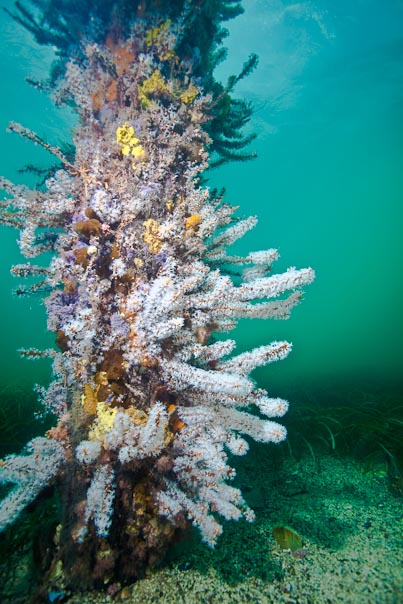
But now for the good part! Operation of the controls was an absolute delight. The shutter performance through the housing felt amazing, with a sensitive but positive action. I could fire off shots as quickly as I wanted (strobes permitting) without having to manage the eight seconds per frame I was used to from my Olympus in raw mode. The ultra fast low-light auto focus caught me by surprise again and again as the camera was ready to take the shot before I was! In short, every gripe I had ever had with my previous compact experience was not only put to rest but done so spectacularly.
So, even though I did not get any fantastic images from my first dive, I know this will only be a matter of time, practice, lots of diving and just getting to know my way around all the controls.
Maybe I'll never really tame the beast, but we've got off to an excellent start. I know we'll make a great team.
Until the next post, take care out there and keep diving ( if that's what you do! ) ...Robert
Photos: Robert Rath, 5DMkII, Port Hughes Jetty
Monday, September 7. 2009
Nexus Underwater Housing With Canon EF 17-40mm Zoom
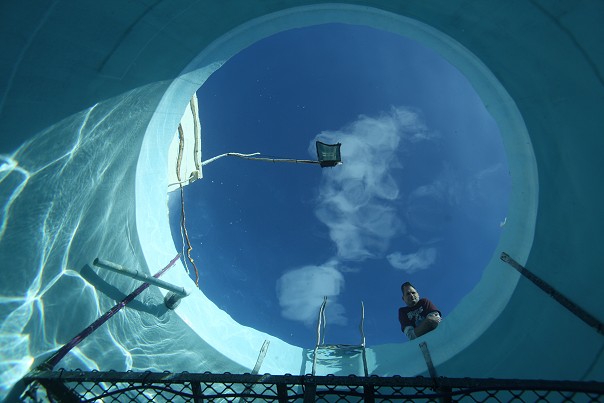
New housing, initial configuration, first dive, first photograph. This image taken from the bottom of the tank looking skyward is quite a fun shot but after a little while it became evident to me that something was not quite right. After 30 minutes of 'snaps' and subsequent review I noted that the edges of my shots were often soft and my close focus capability was not what I expected. It was time to take a crash course in dome optics to try and understand these issues.
My initial configuration of Nexus M6 underwater housing , FP-160 dome with 40mm extension for the Canon EF 17-40mm zoom was set up for me by the guys at Sea Optics here in Adelaide. David and Carey have looked after me well over the last few years, given good advice and been patient with all my questions. This configuration was a first for them so they are just as eager as I am to get this combination right. After dive one it was time to debrief.
Dome ports provide underwater photographers with the ability to use wide angle lenses without field-of-view robbing diffraction and the well understood underwater magnification factor of 1.3x. For a wide angle photograph, you really need to restore the full field of view and this is what dome ports are good for. Unfortunately they are not always easy to get right, especially if you try and use a lens not actually designed for the job.
After a first round of googling, I discovered the existence of three key magic parameters in getting a dome configuration right: 'dome focal point', 'virtual infinity' and 'entry pupil'. The first of these is quite easy to get your head around. The focal point of a spherical dome is at the radius of its curvature. The second, the virtual infinity is some point in front of the dome where everything from you out to infinity has been compressed. The general rule of thumb here is three times the internal dome radius. In other words, if you have a dome with a radius of 8cm, then the entire undersea world will exist as a virtual image somewhere between the surface of the dome and the virtual infinity at 24cm. The last and most mysterious of these magic parameters is the 'entry pupil' of the lens. This is the point through which all rays of light converge within the lens on their way to the CCD, imager or film pane. It is generally the same point where the aperture control of the lens is placed. Now just to really mess with your head, it's not the real location of the aperture but the virtual one, and it moves around as you change zoom, focus and F-stop setting!
A bit of searching will reveal a host of techniques for locating the entry pupil location of a lens. This is a hot topic for photographers who stitch together multiple photographs for panoramic image creation, especially panoramas involving objects at close range. My favourite method involves simply placing your camera on a sheet of blank paper and drawing two parallel vertical lines up the left and right edge of the image as seen through the viewfinder or preview screen. Take away the camera and then extend these two lines to find where they cross. This is the point within the lens where the entry pupil exists. You will need to repeat this for all combinations of zoom length, focus and aperture and then use the average.
Armed with a bit of knowledge I sat down with my gear, rulers, paper and pencil and here's what I found my initial set-up actually looked like geometrically:
Figure 1. Evaluation of Initial Optical Performance
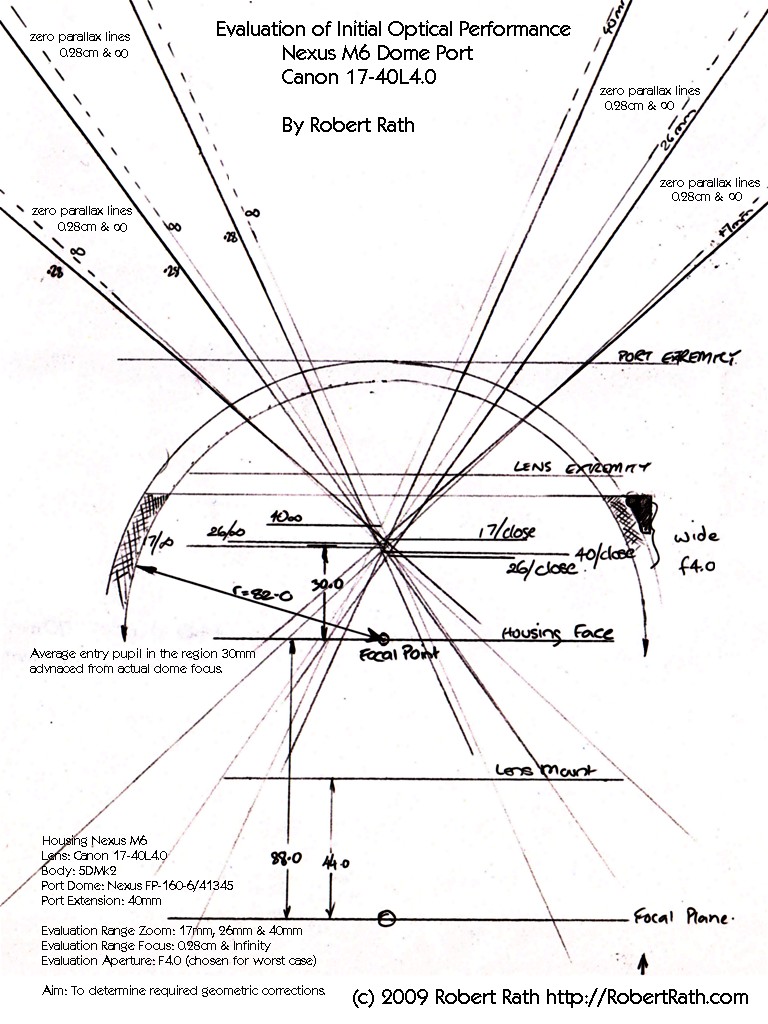
Test Details
Housing Nexus M6
Lens: Canon EF 17-40mm F4.0L
Body: 5DMk2
Port Dome: Nexus FP-160-6/41345
Port Extension: 40mm
Evaluation Range Zoom: 17mm, 26mm & 40mm
Evaluation Range Focus: 0.28cm & Infinity
Evaluation Aperture: F4.0 (chosen for worst case)
Aim: To determine required geometric corrections.
Findings
All test/measurements were done at F4.0 on the assumption that this is the worst possible F-stop to get right. Subsequent measurements show a small movement in 'entry pupil' location as F-stops changed, but insignificant compared to the benefits of smaller apertures.
What I found was that the lens appeared to be located 30mm forward of the optimal location based on dome curvature. In an ideal world I'd just add another 30mm of extension and repeat just to confirm the measurements were correct, but alas, nothing is simple with underwater photography. Moving the dome forward will create significant vignetting of the image as the dome structure obscures some of the light and competes as a virtual aperture. This is because the dome is not a full hemisphere.
I plan to experiment with a combination of diopters and extension lengths to address the following three issues:
a) Correcting the entry pupil location to assist keeping the entire frame sharp.
b) Removing the vignetting associated with moving the dome forward.
c) Bringing the virtual foreground closer to the dome surface for better close focus performance without losing infinity.
My next two tests will be done with:
a) An extra 20mm of extension and a +2 diopter, and
b) An extra 30mm of extension with a +4 diopter.
I will write about my rationale for their selection in a later post along with my results.
Until the next post, take care out there and keep diving ( if that's what you do! ) ...Robert
Thursday, July 9. 2009
Finding The J-Spot On The Nokia N97
 I recently became the proud owner of Nokia's new n97. One of the included trial applications which just blew me away for its 'utility' value is 'JoikuSpot' by Joikusoft.
I recently became the proud owner of Nokia's new n97. One of the included trial applications which just blew me away for its 'utility' value is 'JoikuSpot' by Joikusoft.Please visit my post titled Finding The J-Spot On The Nokia N97 at Innovation Mentor for my thoughts.
...Robert
Sunday, May 3. 2009
Mr. Ray's an Edithburgh Local
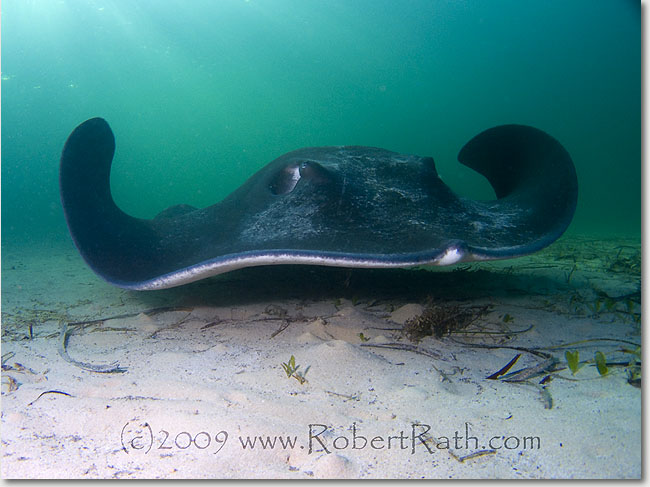
A couple of weekends ago we were in Edithburgh again joining Paul McDonald for his first PADI DUWP course. It was fun just being involved without leading the course. A chance to just dive and take photos and be with a bunch of people who love diving and cameras. Over the weekend we dived at Edithburgh and Wool Bay. I even had the chance to do my first night dive here in ages even if it was cut a little short as I watched the tide rising inside the lens of my torch. Oh well it had served me well for more than 15 years so time to get a new one anyway.
I am delighted to say that Mr. Ray was here under Edithburgh Jetty again to pose for our cameras. I have seen this ray on many dives here over the last year and I am convinced it is the same ray. So officially or not I am declaring Mr. Ray an Edithburgh local.
I'll be posting a few more images from this weekend over the next few days so keep an eye out for some of the interesting critters we came across.
Until the next post, take care out there and keep diving ( if that's what you do! ) ...Robert
Photo: Robert Rath C7070 1/125s at f/3.5 ISO200 Inon UWL100-28AD Lens, Strobe + Natural Light
Thursday, April 30. 2009
South Australian Tourism and Leafy Seadragons
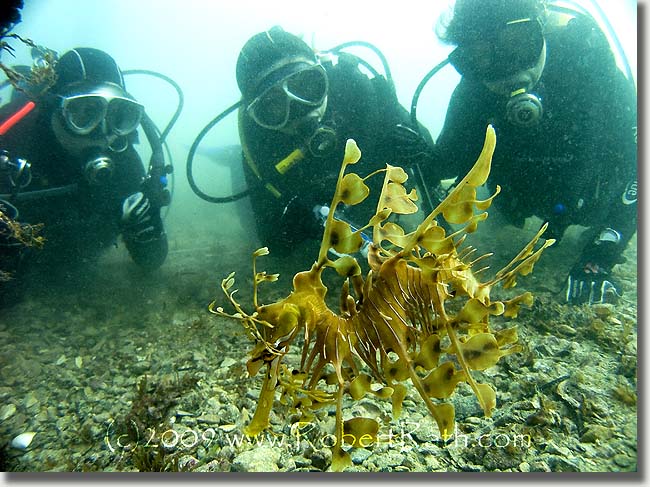
I have just had the pleasure of spending the last two days diving with my new Japanese friends, Yuko, Hiroko and Masashi, who all made a special trip to Adelaide in South Australia to see our wonderful Leafy Seadragons.
Two things that always go through your mind when organising to dive somewhere are that you hope that the weather will be nice, and you hope that you get to see or do what you are planning.
The same goes for those who host such dives. We always want to show off South Australian diving in its best possible light. I had been very stressed in the days leading up to these dives as South Australia had just experienced some of its worst weather in years. Our beautiful waters had turned into silty chaos and the sea was looking decidedly uninviting. As luck would have it, the two days we had planned turned out to be the calm between two storms. We at least got blue sky and gentle seas, but the visibility would be a challenge.
We spent a day at Rapid Bay and a day at Victor Harbor. Although visibility ranged from 1-3 metres both days, that did not stop Yuko and Masashi from going camera crazy and being the cause of future Leafy cataracts with their strobes. I do not envy them the backscatter they will have to peer through when they get home. Hiroko was happy to just look on; I'm sure I heard her squeal with delight on more than one occasion.
Thirteen beautiful Leafy Seadragons and one stunning Weedy Seadragon; result, three ecstatic Japanese guests taking photos and stories home.
Until the next post, take care out there and keep diving (if that's what you do!) ...Robert
Photo: Robert Rath C7070 1/90s at f/2.8 ISO200 Inon UWL100-28AD Lens, Natural Light
Tuesday, March 24. 2009
Experiments in Photographic Art - Henley Beach Jetty
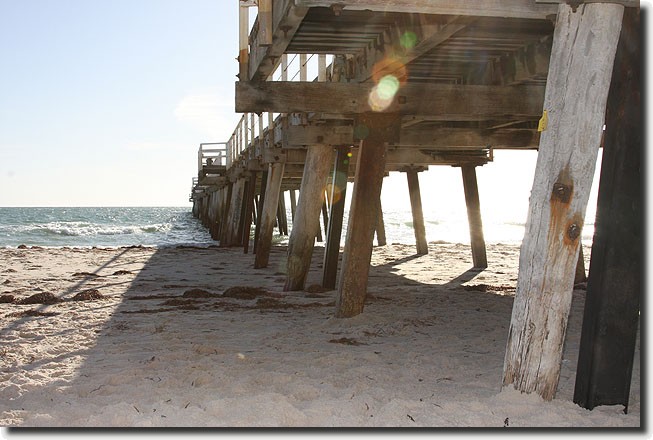
I took some quite ordinary photos at the beach yesterday and was about to throw them forever into the eternal pit of hard drive wilderness but then decided instead to play around a little first. Inspired by some of the photographic art of Stephen Kiernan, I took a very average JPG photo with blown out exposure and all sorts of other faults. The only thing going for it was that I liked the composition.
I then started plying around disrespectfully with the controls of my photo editing program. Colour saturation was the first casualty, set to maximum. I played around with the gamma on individual colour channels and finally did a little colour replacement. All very uncool things to do to a photograph but the result is quite interesting.
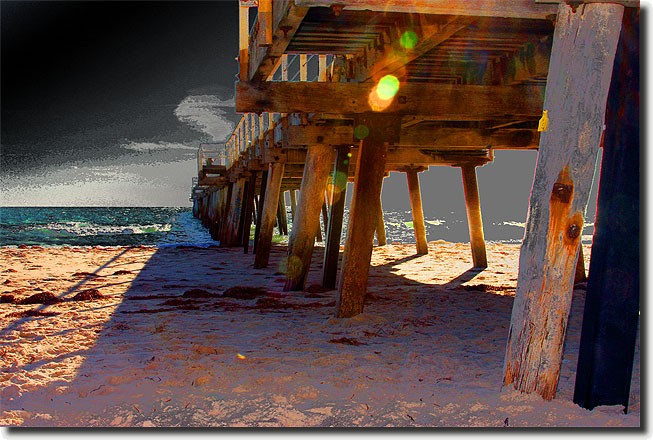
For some really stunning examples of HDR (High Dynamic Range) images, visit Stephen's Flickr Stream and let me know what you think.
Until the next post, take care out there and keep doing stuff ( if that's what you do! ) ...Robert
Monday, March 23. 2009
Lilies On The Kitchen Table
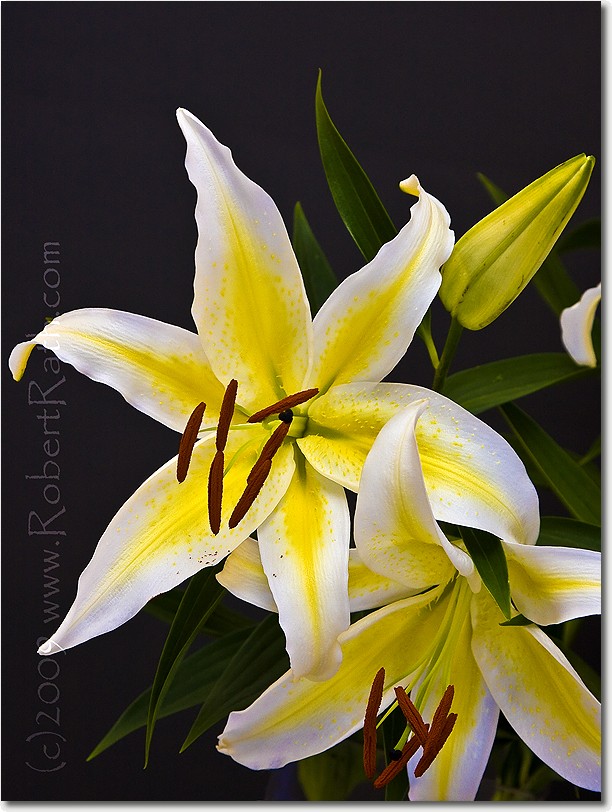
Just in case any of you wondered, yes I do take photographs on dry land from time to time.
I had just finished a tutorial in lighting and was eager to try out some new ideas. Looking around the room I spied a beautiful vase of lilies Jennifer had bought to brighten up the house. A likely candidate I thought and started playing with various combinations of natural light, strobe light and composistion.
This final image was made using mostly strobe light bounced off the ceiling with only a small amount of natural daylight coming in through the windows. The dark background is from the dining room table.
Until the next post, take care out there and keep taking fantastic photos ( if that's what you're into! ) ...Robert
Photo: Robert Rath 40D 1/15s at f/6.3 ISO500, Zoom 73mm, Strobe + Natural Light
Thursday, March 19. 2009
The New Rapid Bay Jetty, South Australia
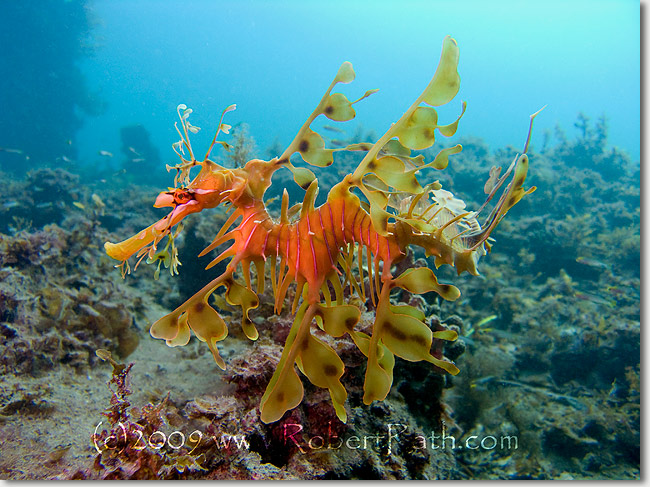
Well the new Rapid Bay Jetty has been open now for a few weeks and I can honestly say it is worth the wait and worth the cost.
I have been diving Rapid Bay Jetty for more years than I care to remember. I remember the long walk to the old T-section and the original diver's platform. Back then you would cart your day's diving gear out in the morning, set up camp and dive and enjoy surface intervals right there where you jumped in the water. All that came to an end with the closure of the old jetty some years back.
For many years now diving the jetty has meant an ankle twisting rocky shore entry and exit and a very long swim out and back leaving little strength or enthusiasm for multiple dives. That has all changed now with the opening of the new jetty along side the old one.
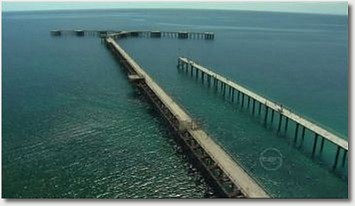
The new jetty runs parallel to the old one and for about half the original jetty's length providing a nice easy walk from the car park to the new divers platform. The divers platform has been staged so that there is 'walk in' access over quite a range of tide heights. On a really low tide you might need to use the ladder on the bottom platform. All this beats scrambling over an unstable rocky beach by far.
Rapid Bay Jetty is a wonderful dive and a photographer's dream when the visibility is good. It is famous as a haunt for Leafy Seadragons and attracts visitors from all over the world who come to see these fantastic creatures. With the new jetty they can now dive in safety and comfort.
Until the next post, take care out there and keep diving ( if that's what you do! ) ...Robert
Photo: Robert Rath C7070 1/125s at f/2.8 ISO100, Inon D2000 Strobe + Natural Light, Jetty - Courtesy ten.com.au
Thursday, March 5. 2009
Chumby, Meet Facebook - Facebook, Meet Chumby
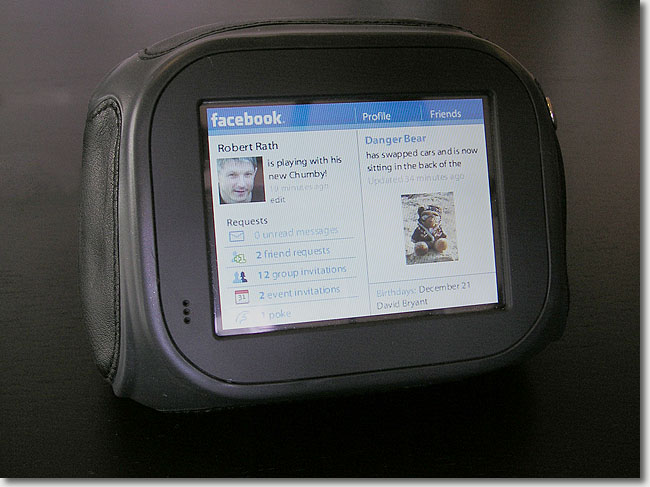
All my friends know I love gadgets and so it will come as no surprise that Jennifer gave me a very, very cool gadget for my birthday called a 'Chumby'.
What is a Chumby? Well it kind of looks like a little bean bag with a LCD screen. The real question is what can you do with a Chumby or more importanly what can a Chumby do for you?
Wired magazine dubbed chumby one of the cool gadgets of 2008, praising it for bringing "the friendlier face of the Internet into our homes...it did it while disguised as a teddy bear for the 21st century".
The first thing my Chumby did on being brought to life was to show the time in San Diego and stream snippets of late night American chat shows. Impressive but not useful. However after a short time my Chumby, renamed Scuby, was showing my Facebook updates and streaming my favourite podcast at Killer Innovations.
So a Chumby is a WiFi multi-media marvel in a bean bag. It will sit on your desk, the mantelpiece or by the side of your bed and do what ever you want it to do. Just install the widgets you like or roll your own as it is fully 'open source'.
Until the next post, take care out there and keep playing with gadgets ( if that's what you do! ) ...Robert
Sunday, March 1. 2009
Juvenile Weedy Seadragon, Victor Harbor
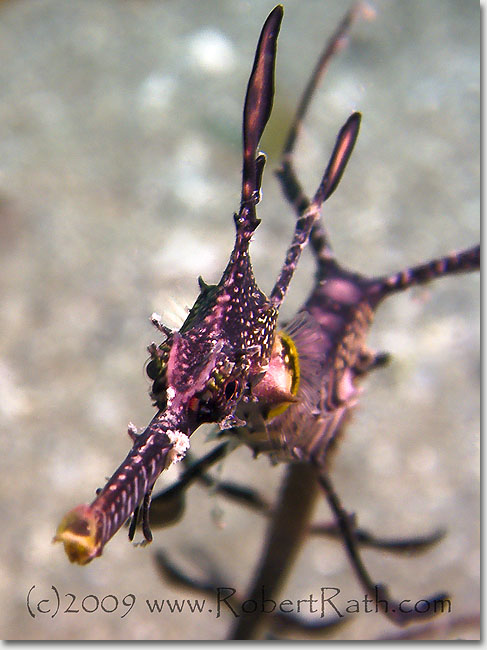
The Weedy Seadragon, Phyllopteryx taeniolatus , is also one of our two famous and unique Southern Australian seadragons.
There is much debate in our diving community here in Adelaide if the Weedy Seadragon is more common than the Leafy Seadragon. I guess that depends on where you dive. In my experience with shore based shallow diving here in South Australia I would say that the Leafy Seadragon is more common and the Weedy Seadragon is less common. On deeper off-shore reefs I have only ever found Weedy Seadragons. Even so, I have dived other parts of Australia where I have seen plenty of Weedy Seadragons in shallow shore based diving. In any case these dragons are hard to see even when right in front of you due to their magnificent camouflage.
This photo was taken at Victor Harbor a couple of weekends ago. It was a juvenile, around 10cm in length and was spotted by my dive buddy. Note that this little dragon is all covered in white silt! Many thanks to my buddy who left both of us in a cloud of muck and silt has he raced off after a cowfish swimming past. Note to non-photographer dive buddies; be aware of your fins and fragile bottoms!!
Until the next post, take care out there and keep diving ( if that's what you do! ) ...Robert
Photo: Robert Rath C7070 1/90s at f/8.0 ISO100, Inon UCL165AD Macro Lens, Inon D2000 Strobe + Natural Light
Thursday, February 26. 2009
Aha Moments

A recurring theme in conversations with successful individuals is some defining moment, an 'aha' moment often prompted by a saying or a quote. Suddenly veils and obstructions vanish and what needs to be done becomes clear to achieve your gaols.
Jennifer Liston in her post 'Revelationary Statements', shares one of those moments. Read about Jennifer's 'Aha' moment at http://www.wordsworx.com and share your own experience.
More of my thoughts and insights on innovation, creativity and business can be found at - http://www.innovation-mentor.com
Monday, February 23. 2009
Finding the Beautiful Elusive Leafy Seadragon
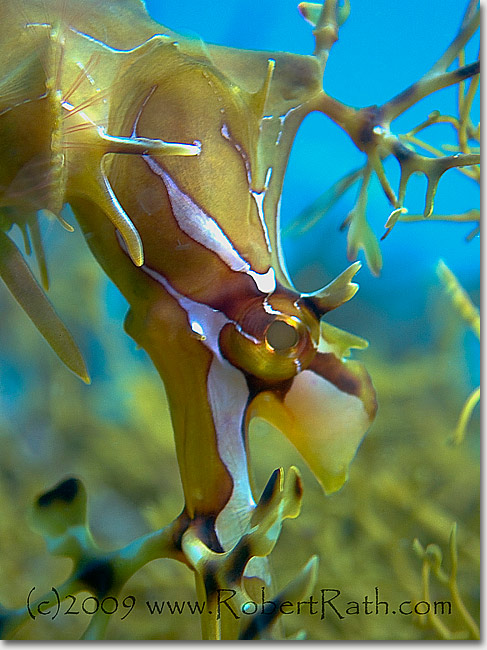
I dive with Leafy Seadragons often as part of being a tour guide for visitors to Adelaide who want to experience them for themselves. So far I count myself lucky that I've never disappointed anyone and have always been able to find them.
Following my last 'Leafy' dive, a group of us were discussing these creatures and how to find them. We all agreed that until you actually see your first Leafy, you have no idea what you are looking for. They are true masters of camouflage. All the photographs in the world do not prepare you for how they really look in their natural surroundings. As soon as you see your first one for real, it becomes somewhat easier.
When I was asked how do I find them, my first reply was that they are obvious. Of course this is not a very useful answer to anyone at all. I thought about it a little more and I came to realise that familiarity is everything. While I am diving, I look for those places where I know Leafys like to be. They like to be tucked in close to their surroundings, yet still free to move about quickly. They like to be in opportunistic locations, where plankton-like animals are likely to swim by in swarms. They don't mind a little surge as long as the surge deosn't separate them from their cover. They don't like ledges or dark places because there is not much for them to eat. So I pretend I am a Leafy Seadragon, I look for a cosy little broad-leafed spot with plenty of passer-by morsels. More often than not I will find one already there!
This photo was taken at Victor Harbor last weekend and as usual, stunning and beautiful.
Jennifer has written a short log about about the dive at her 'Dive Blog' so please visit her site and leave a note at http://scubacailin.blogspot.com/2009/02/dive-133-lovin-local-leafies.html
Until the next post, take care out there and keep diving ( if that's what you do! ) ...Robert
Photo: Robert Rath C7070 1/90s at f/4.8 ISO100, Inon UCL165AD Macro Lens, Inon D2000 Strobe + Natural Light
Sunday, February 8. 2009
Smooth Stingray, Edithburgh
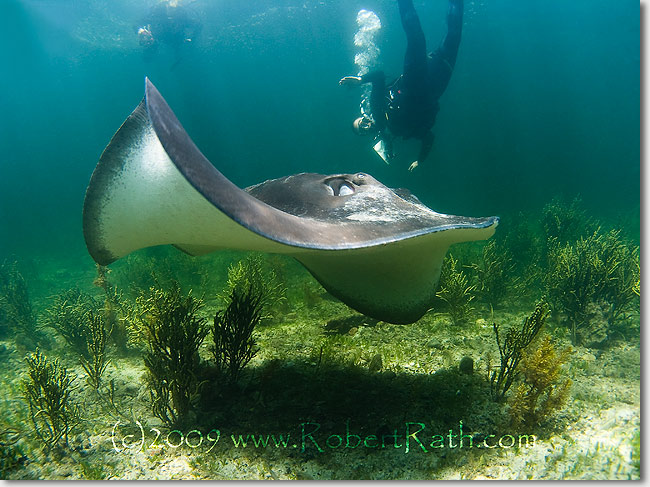
The Smooth Stingray, Dasyatis brevicaudata, grows up to 2m across and 4.3m in length making it the largest of all Australian stingrays. This fellow who we dubbed 'Mr Ray' was at least 1.5m across and was the highlight of our first dive in Edithburgh last Saturday. Mr Ray was quite curious about us and buzzed us a few times during the dive usually by sneaking up from behind and scaring the daylights out of us!
This first dive set the scene for a great underwater photography course with Mark, Bel, Peter, Jennifer and myself. With the recent hot weather we have been having here in South Australia the water temperature is way up. 25 degC made for almost tropical diving and all of us lamented our limited air and camera battery life. We all could have stayed underwater the entire weekend!
Until the next post, take care out there and keep diving ( if that's what you do! ) ...Robert
Photo: Robert Rath C7070 1/90s at f/2.8 ISO80 Inon UWL100-28AD Lens, Natural Light
Tuesday, January 20. 2009
Black Is The New Black
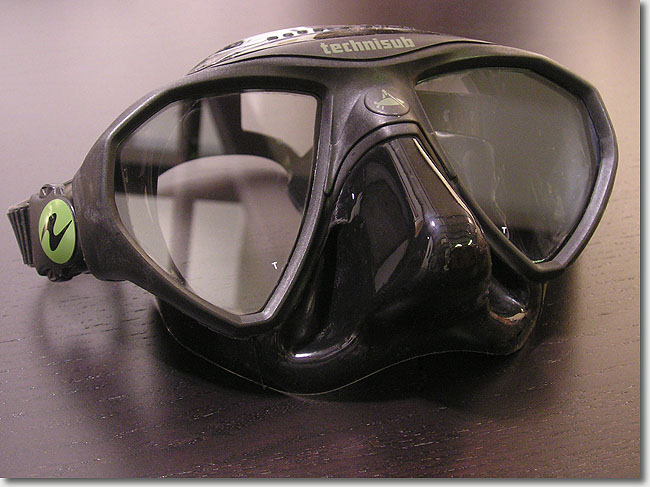
I'd been shown this mask some time back now and last Friday I borrowed one for a dive. I loved it so much I bought my own the very same day.
I have been hearing the pros and cons of black masks for years. I have always loved the extreme peripherial vision that comes with a mask with a clear silicon skirt, in spite of the lack of clarity through the skirt. The need to be aware of other divers on the extreme periphery has always been the priority for me as a dive instructor.
Enter Aqualung's Micromask...
This mask is simply amazing in how it sits so close to your face and how little volume it has. I can nearly touch the glass with my eye lashes. Doing a mask clear requires little more than a puff of air. With this mask sitting so close to my face, the peripheral vision is excellent. Maybe it is not quite as good for that extreme peripheral awareness, but the peripheral vision you do have is through glass - and uncompromised.
Black Is Best ... or My Unbiased Product Review ( honest I paid full price for mine! )
So why are black masks popular? Well, the disadvantage of having any source of light coming from behind the mask lens is that of internal reflection and glare. This light can come in through a clear mask skirt or through side lenses. At best, it will reduce the perceived contrast of your primary vision. At worst, it will be distracting and annoying.
The Cons
I think I only found two points about this mask which could be improved. The first is the design of the buckle. Even though it does its job very well, it does have multiple plastic parts, which increases its potential for failure. In comparison, a mask like the Mares X-Vision binds to the skirt giving the same flexibility with no breakable parts. My second point of issue, although minor, is the extreme shininess of the black silicon on the inside of the mask. I found that this shininess can also lead to reflections and glare, so I will be getting stuck into it with some fine grade wet-rub until it is nice and matt.
Summary
In 18 years of diving, the Technisub Micromask is my first ever black mask. It solves my old complaint of poor peripheral vision, prevents the glare from side and back lighting, clears with the slightest puff of air and most importantly it fits my face like a glove. I am very happy with my new mask and have to agree that black really is the new black!
As an aside, trying to take a good photograph of a shiny black silicon mask was much more difficult than some of the marine life I photograph! Try it yourself!
Until the next post, take care out there and keep diving ( if that's what you do! ) ...Robert
Tuesday, January 13. 2009
Weedy Seadragon, Victor Harbor
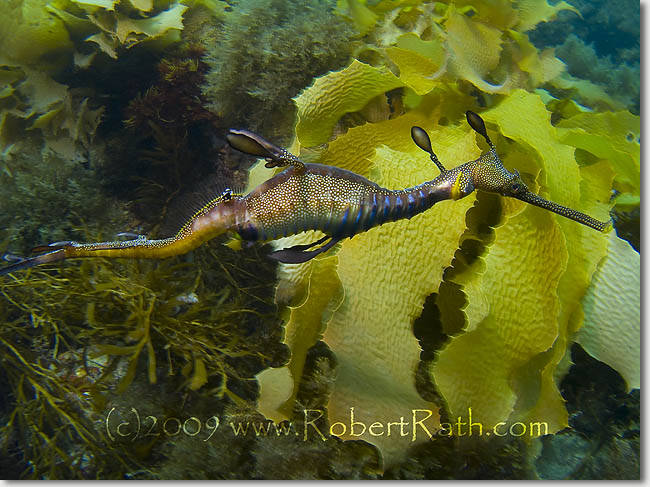
The Weedy Seadragon, Phyllopteryx taeniolatus is endemic to South Australian temperate waters. Like its close relative, the Leafy Seadragon, you will not find it anywhere else in the world.
Seadragons are closely related to seahorses but, unlike seahorses, they do not have an egg pouch for brooding. Instead, the males brood their young by attaching the eggs to their tail and looking after them until they hatch. Meanwhile, mum has long gone! Actually she's probably not far away, but will have nothing to do with raising children!
This was my first dive for the year and was an opportunity to take my Argentinian guest, Gustavo, on a mission to see and photograph Leafy Seadragons. In all we found seven 'leafys' so the Weedy was a delightful bonus. It sure is nice to be back in the water again.
Until the next post, take care out there and keep diving ( if that's what you do! ) ...Robert
Photo: Robert Rath C7070WZ 1/30s at f/8 ISO80, Lens Inon UWL100-28AD Lens, Inon D2000 Strobe
Friday, January 9. 2009
Testing an iFrame Version of WetShutter
Ok, so the use of the iFrame tag is a way to place rich content into a blog post if supported. The question for me now is, can you all see the rich content?
As an experiment, here is a Flash demo of some of my photos using an iFrame. Please comment on what you end up seeing in your own browser.
Until the next post, take care out there and keep using iFrames ( if that's what you do! ) ...Robert
Testing Google Maps - My Little part of the World
While looking at how to make the content of my blog posts richer I happened across the mechanism of embedding a GoogleMap right where I want to show you something.
So here it is, one of our favourite places to go for coffee, dinner, a swim or maybe catch an awesome Henley Beach sunset. My next challenge will be to work out how to do a low pass fly by!
Until the next post, take care out there and keep Googling ( if that's what you do! ) ...Robert
Saturday, December 20. 2008
Adobe Backscatter Removal Action and Tutorial By Daniel Brown
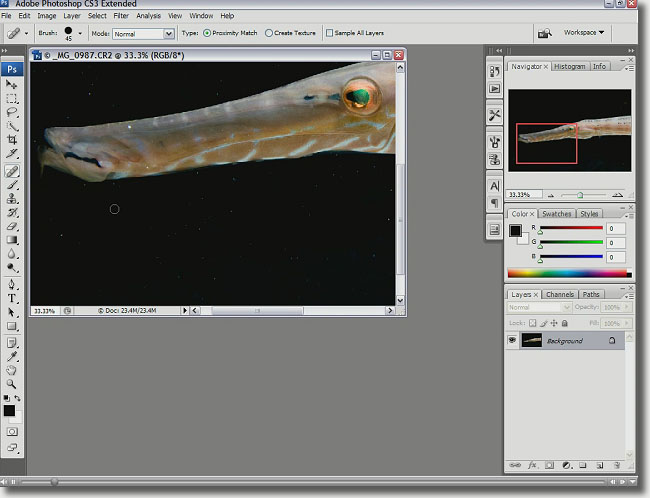
If your are starting to suffer RSI from removing backscatter from your images then you might like to look at this tutorial by Daniel Brown of http://www.downloadculture.com.
In his article Daniel provides an Adobe Action which largely automates the process. There is still some work required hence the need to watch the video tutorial at http://www.downloadculture.com/uw/bs2007.html
To do this yourself you will need a copy of Daniel's Actions, http://www.downloadculture.com/uw/backscatter.zip or here adobeAction_backscatter.zip
I have spent a little time now with this tool and it is very effective for some kinds of images. It is especially useful for silhouettes where the backscatter is not mixed in with the detail. If there is a lot of detail where the backscatter exists then it's back to the old tools such as the clone stamper or the healing brush ... and the RSI!
Until the next post, take care out there and keep diving ( if that's what you do! ) ...Robert
Tuesday, December 16. 2008
Baby Anemone Fish, Which One Is Nemo?
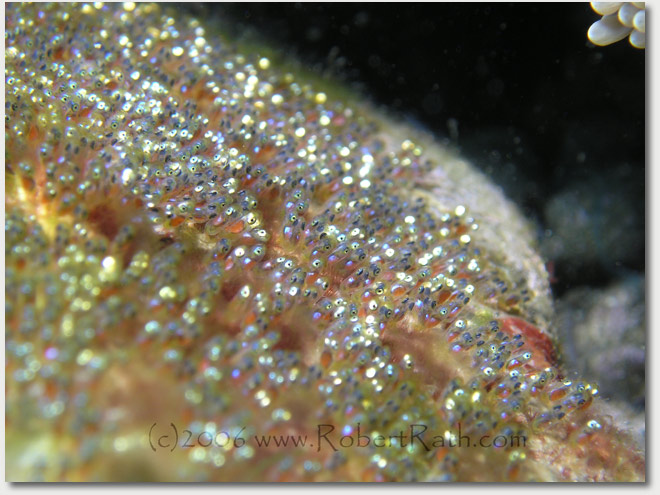
This photograph taken of a clutch of Anemone Fish eggs clearly shows a bunch of youngsters patiently awaiting their escape into the world. These eggs were attached to a smooth rock on top of which was large Anemone along with doting parents.
When I took this photo the detail was not evident. Later on it was obvious how much detail there was in the developing babies. I have included a detailed close-up of a small section which really emphasise this. Next time I come across a clutch of eggs like this I plan on taking macro images.
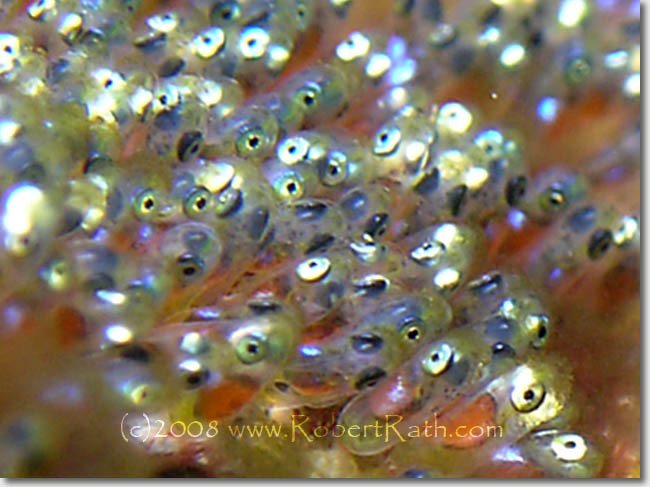
So where are Mum and Dad? Jennifer was fighting them off while I took this photograph!
Until the next post, take care out there and keep diving ( if that's what you do! ) ...Robert
Photo: Robert Rath C5060WZ 1/90s at f/8 ISO100, Inon D2000 Strobe
« previous page
(Page 74 of 78, totaling 2313 entries)
» next page



